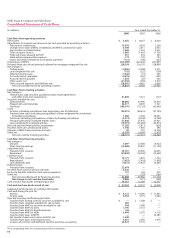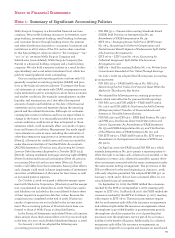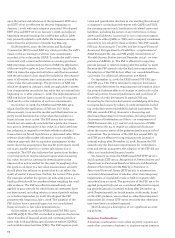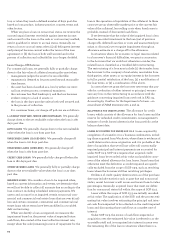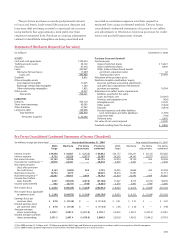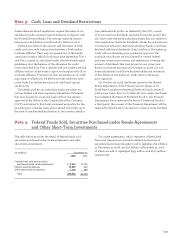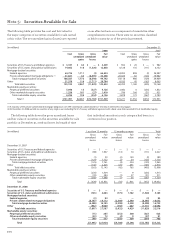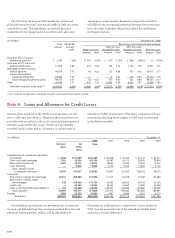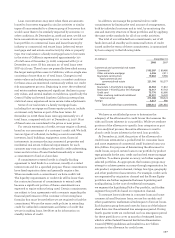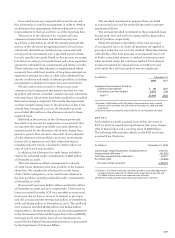Wells Fargo 2008 Annual Report Download - page 102
Download and view the complete annual report
Please find page 102 of the 2008 Wells Fargo annual report below. You can navigate through the pages in the report by either clicking on the pages listed below, or by using the keyword search tool below to find specific information within the annual report.
value with changes in fair value included in earnings, and
immediately recognize gains and losses that were accumulated
in other comprehensive income in earnings.
In all other situations in which we discontinue hedge
accounting, the derivative will be carried at its fair value in
the balance sheet, with changes in its fair value recognized in
current period earnings.
We occasionally purchase or originate financial instru-
ments that contain an embedded derivative. At inception of
the financial instrument, we assess (1) if the economic char-
acteristics of the embedded derivative are not clearly and
closely related to the economic characteristics of the finan-
cial instrument (host contract), (2) if the financial instrument
that embodies both the embedded derivative and the host
contract is not measured at fair value with changes in fair
value reported in earnings, and (3) if a separate instrument
with the same terms as the embedded instrument would meet
the definition of a derivative. If the embedded derivative
meets all of these conditions, we separate it from the host
contract by recording the bifurcated derivative at fair value
and the remaining host contract at the difference between the
basis of the hybrid instrument and the fair value of the bifur-
cated derivative. The bifurcated derivative is carried as a
free-standing derivative at fair value with changes recorded
in current period earnings.
Revenue Recognition
We recognize revenue when the earnings process is com-
plete, generally on the trade date, and collectability is
assured. Specifically, brokerage commission fees are recog-
nized in income on a trade date basis. We accrue asset man-
agement fees, measured by assets at a particular date, as
earned. We recognize advisory and underwriting fees when
the related transaction is complete. We record commission
expenses when the related revenue is recognized.
For derivative contracts, we recognize gains and losses at
inception only if the fair value of the contract is evidenced by
a quoted market price in an active market, an observable
price of other market transactions or other observable data
supporting a valuation technique. For those gains and losses
that are not evidenced by market data, we use the transaction
price as the fair value of the contract, and do not recognize
any gain or loss at inception. Any gains or losses not meeting
the criteria for initial recognition are deferred and recognized
when realized.
On December 31, 2008, we acquired all outstanding shares of
Wachovia Corporation (Wachovia) common stock in a stock-
for-stock transaction. Wachovia, based in Charlotte, North
Carolina, was one of the nation’s largest diversified financial
services companies, providing a broad range of retail bank-
ing and brokerage, asset and wealth management, and corpo-
rate and investment banking products and services to cus-
tomers through 3,300 financial centers in 21 states from
Connecticut to Florida and west to Texas and California, and
nationwide retail brokerage, mortgage lending and auto
finance businesses. In the merger, Wells Fargo exchanged
0.1991 shares of its common stock for each outstanding share
of Wachovia common stock, issuing a total of 422.7 million
shares of Wells Fargo common stock with a December 31,
2008, value of $12.5 billion to Wachovia shareholders. Shares
of each outstanding series of Wachovia preferred stock were
converted into shares (or fractional shares) of a correspond-
ing series of Wells Fargo preferred stock having substantially
the same rights and preferences. Because the acquisition was
completed at the end of 2008, Wachovia’s results of opera-
tions for 2008 are not included in our income statement.
The Wachovia acquisition was accounted for under the
purchase method of accounting in accordance with FAS 141.
The statement of net assets acquired as of December 31,
2008, purchase price and the computation of goodwill related to
the merger of Wells Fargo and Wachovia are presented in the
following table.
Note 2: Business Combinations
The assets and liabilities of Wachovia were recorded at
their respective acquisition date fair values, and identifiable
intangible assets were recorded at fair value. Because the
transaction closed on the last day of the annual reporting period,
certain fair value purchase accounting adjustments were based
on data as of an interim period with estimates through year end.
Accordingly, we will be re-validating and, where necessary,
refining our purchase accounting adjustments. We expect that
the refinements will focus largely on loans with evidence of
credit deterioration. The impact of any changes will be recorded
as an adjustment to goodwill. Additional exit reserves related
to costs associated with involuntary employee termination,
contract termination penalties and closing duplicate facilities
will be recorded within the next year as part of the further
integration of Wachovia’s employees, locations and operations
with Wells Fargo. At December 31, 2008, $199 million of exit
reserves in connection with management’s finalized integration
plans have been allocated to the purchase price and included
in the following table.
The pro forma consolidated condensed statements of
income for Wells Fargo and Wachovia for the years ended
December 31, 2008 and 2007, are presented on the following
page. The unaudited pro forma information presented does
not necessarily reflect the results of operations that would
have resulted had the merger been completed at the begin-
ning of the applicable periods presented, nor does it indicate
the results of operations in future periods.


